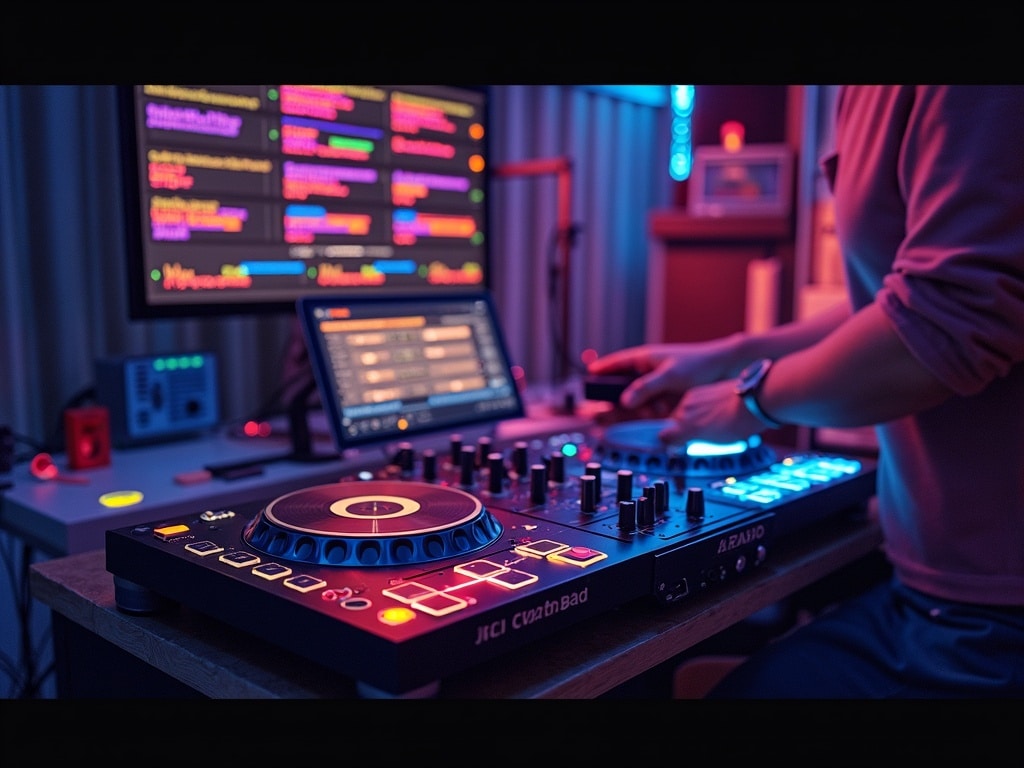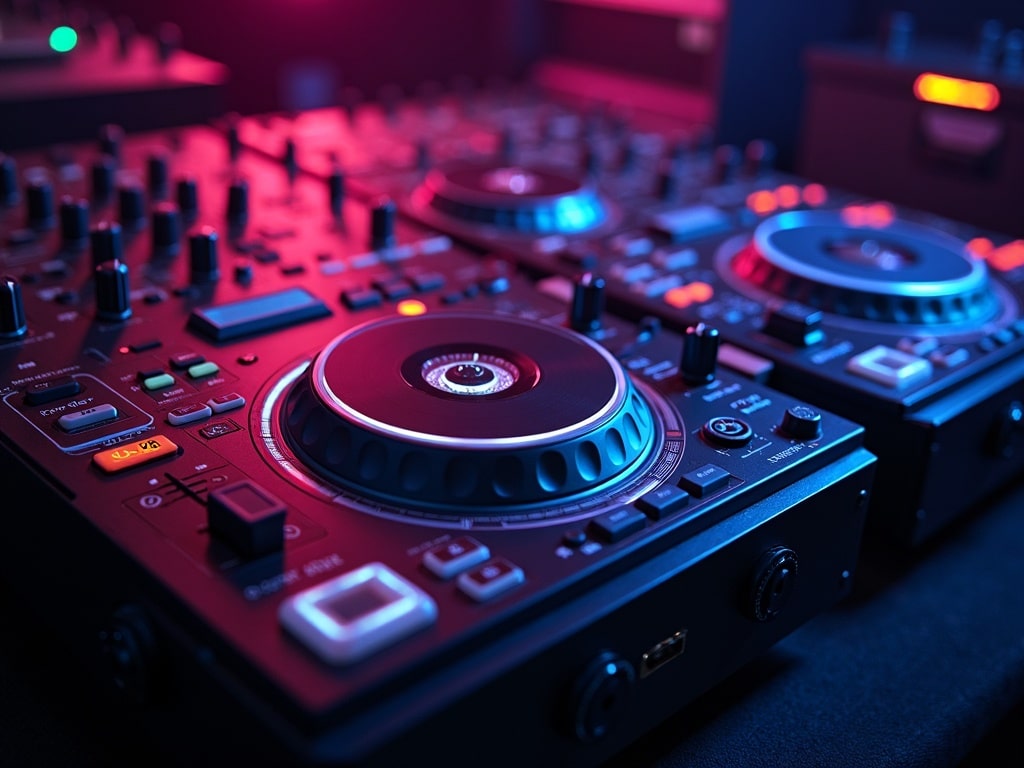Secret Weapons: Unlock the Power of a Perfectly Organized DJ Music Library
What is a DJ Music Library and Why is it Important?
Imagine a master chef reaching for ingredients in a chaotic, overflowing pantry. Frustration mounts, time is wasted, and the culinary masterpiece suffers. This is the plight of a DJ with a disorganized music library. Your DJ music library is the heart and soul of your performance – a curated collection of tracks ready to ignite the dance floor. But without organization, it's just a digital mess.
A well-organized DJ music library is more than just neatness; it's about:
- Efficiency: Instantly find the perfect track to keep the energy flowing.
- Creativity: Discover hidden gems and unexpected combinations within your collection.
- Professionalism: Project confidence and control at every gig.
- Peace of Mind: Knowing your music is safe, accessible, and ready to rock.
Think of your music library as your DJ instrument. Just like a guitarist meticulously cares for their guitar, you need to cultivate a system that empowers your creativity and performance.
Understanding Music File Formats (MP3, WAV, FLAC, AAC)
Before you even start organizing, understand the different file formats you'll encounter. Each format has its pros and cons in terms of sound quality and file size:
- MP3: The most common and compatible format. Offers a good balance between sound quality and file size, making it ideal for large libraries. However, it's a lossy format, meaning some audio data is compressed and lost. Aim for 320kbps MP3s for the best possible quality.
- WAV: An uncompressed, lossless format that preserves the original audio quality. WAV files are significantly larger than MP3s. Best for archiving your high-quality source files.
- FLAC: Another lossless format offering excellent sound quality with better compression than WAV. FLAC files are smaller than WAV but still larger than MP3. A good option for audiophiles who want the best of both worlds.
- AAC: Similar to MP3 but often provides slightly better sound quality at the same bitrate. Commonly used by Apple (iTunes/Apple Music).
Recommendation: For DJing, 320kbps MP3s are generally sufficient. Use WAV or FLAC for your master library if sound quality is your utmost priority and you have ample storage space.
Choosing the Right DJ Software for Library Management
Your DJ software is your primary tool for organizing and accessing your music. Popular options include:
- Serato DJ Pro/Lite: Known for its stability, intuitive interface, and powerful library management features.
- Rekordbox DJ: Pioneer DJ's software, seamlessly integrates with their hardware and offers advanced track analysis and organization tools.
- Traktor Pro: Native Instruments' flagship DJ software, renowned for its flexibility, customization options, and advanced effects.
- Virtual DJ: A versatile option with a wide range of features, catering to both beginners and experienced DJs.
Key Considerations:
- User Interface: Choose software with an interface that you find intuitive and easy to navigate.
- Features: Look for features like playlist creation, smart playlists, crate management, and advanced search capabilities.
- Hardware Compatibility: Ensure the software is compatible with your DJ controller and other audio equipment.
- Trial Period: Take advantage of free trials to test out different software and see which one best suits your needs.
Creating a Consistent File Naming Convention
A consistent file naming convention is crucial for easy identification and searching. Here's a suggested format:
[Artist] – [Track Title] ([BPM] [Genre])
Example: Deadmau5 – Strobe (128 Progressive House)
Tips:
- Use clear and concise names.
- Avoid special characters or spaces in filenames. Use underscores (_) instead of spaces.
- Be consistent with capitalization (e.g., always use Title Case).
- Consider adding the year of release if relevant.
Renaming hundreds (or thousands) of files can seem daunting, but there are batch renaming tools available that can automate the process. Programs like Mp3tag (free) are very useful.
Folder Structure and Organization Strategies (Genre, BPM, Key)
Think of your folder structure as the skeletal system of your music library. A well-defined structure makes it easy to browse and locate tracks quickly.
Common Organization Strategies:
- Genre-Based: The most common approach. Create folders for each genre (e.g., House, Techno, Hip-Hop, Drum & Bass) and subfolders for subgenres (e.g., Deep House, Tech House).
- BPM-Based: Organize by tempo (beats per minute). Useful for DJs who blend tracks based on BPM.
- Key-Based: Organize by musical key. Essential for harmonic mixing.
- Year-Based: Organize by release year. Helpful for tracking trends and creating sets with specific eras.
Example Folder Structure (Genre-Based):
Music/ ├── House/ │ ├── Deep House/ │ ├── Tech House/ │ ├── Progressive House/ ├── Techno/ │ ├── Minimal Techno/ │ ├── Detroit Techno/ ├── Hip-Hop/ │ ├── Old School/ │ ├── Trap/
You can combine these strategies. For instance, you could have a main House folder, then subfolders for BPM ranges within that genre (e.g., House/120-125 BPM/).
Tagging and Metadata: The Key to Efficient Searching
Metadata is information embedded within your music files (artist, track title, album, genre, BPM, key, etc.). Accurate tagging is essential for efficient searching and filtering within your DJ software.
Essential Tags:
- Artist: The artist's name.
- Title: The track title.
- Album: The album name (if applicable).
- Genre: The musical genre.
- BPM: Beats per minute.
- Key: Musical key (e.g., Am, Cmaj).
- Year: Year of release.
- Comments: Use this field for additional information, such as energy level, suitability for different set times, or personal notes.
Tools for Tagging:
- Mp3tag (Free): A powerful and versatile tag editor for Windows and macOS.
- TagScanner (Free): Another excellent tag editor for Windows.
- MusicBrainz Picard (Free): Uses acoustic fingerprinting to automatically identify and tag music files.
These tools allow you to batch edit tags, saving you time and effort.
Using DJ Software Features for Library Organization (Playlists, Smart Playlists, Crates)
Your DJ software offers powerful features to further organize your music beyond folders and tags.
- Playlists: Manually curated lists of tracks for specific gigs, moods, or styles.
- Smart Playlists: Automatically updated playlists based on criteria you define (e.g., all tracks with BPM between 120 and 125 in the House genre).
- Crates (Serato DJ): Similar to playlists but offer more advanced features, such as sub-crates and smart crates.
Tips:
- Use playlists to prepare for specific gigs or create themed sets.
- Leverage smart playlists to automatically organize your library based on your tagging.
- Experiment with different playlist structures to find what works best for your workflow.
For example, you might create a smart playlist called Peak Time Bangers that automatically adds any track with an energy rating of 5 stars and a BPM above 128.
Backing Up Your Music Library: Protecting Your Investment
Your music library is a valuable asset. Losing it due to a hard drive failure, theft, or accidental deletion can be devastating. Regular backups are essential.

Backup Strategies:
- External Hard Drive: The most common and affordable option. Regularly copy your entire music library to an external hard drive.
- Cloud Storage: Services like Google Drive, Dropbox, and iCloud provide offsite backup and easy access from anywhere.
- NAS (Network Attached Storage): A dedicated storage device connected to your home network, offering both local and remote access.
Best Practices:
- Implement the 3-2-1 backup rule: 3 copies of your data, on 2 different media, with 1 copy offsite.
- Schedule regular backups (e.g., weekly or monthly).
- Test your backups to ensure they are working correctly.
Maintaining Your Library: Regular Cleaning and Updates
Your DJ music library is a living, breathing entity. It requires regular maintenance to stay organized and up-to-date.
Regular Tasks:
- Remove Duplicate Files: Use duplicate file finders to identify and delete unnecessary copies.
- Correct Inaccurate Tags: Review and correct any errors in your metadata.
- Add New Music: Incorporate new tracks into your library using your established organization system.
- Update Software: Keep your DJ software and tag editing tools up-to-date.
- Re-Analyze Tracks: Periodically re-analyze your tracks in your DJ software to ensure accurate BPM and key detection.
Set aside a specific time each month to perform these maintenance tasks. This will keep your library in top shape and prevent it from becoming overwhelming.
Advanced Tips: Utilizing Cloud Storage and Collaborative Libraries
For more advanced users, consider these tips:
- Cloud Storage: Store your music library in the cloud for easy access from multiple devices and locations.
- Collaborative Libraries: Share your music library with other DJs using cloud storage or network sharing. Great for DJ crews.
Troubleshooting Common DJ Music Library Issues
Even with the best organization strategies, you might encounter issues.
Common Problems and Solutions:
- Missing Files: Double-check that the files are still located where your DJ software expects them to be. Re-link missing files if necessary.
- Corrupted Files: Replace corrupted files with a fresh copy from your backup.
- Inaccurate BPM/Key Detection: Manually adjust the BPM and key in your DJ software or tag editor.
- Slow Performance: Optimize your hard drive and close unnecessary programs to improve performance.
Consult your DJ software's documentation or online forums for specific troubleshooting steps.
How do I ensure all files are tagged correctly?
Ensuring every file is accurately tagged can seem overwhelming, but here's a systematic approach:
- Start with a Good Source: Purchase music from reputable sources like Beatport, iTunes, or record pools that provide well-tagged files.
- Batch Editing: Use tag editing software to batch edit tags for multiple files at once. Select groups of tracks by the same artist or from the same album and apply the same tags to all of them.
- Acoustic Fingerprinting: Utilize tools like MusicBrainz Picard, which uses acoustic fingerprinting to automatically identify tracks and suggest tags based on online databases. This is incredibly helpful for tracks with missing or incorrect information.
- Regular Audits: Periodically review your library to identify and correct any tagging errors. Focus on specific genres or artists each time to make the task more manageable.
- Consistency is Key: Stick to a consistent tagging convention throughout your library to avoid confusion and ensure accurate searching.
What is BPM and Key and how do I identify that?
BPM (Beats Per Minute): Refers to the tempo or speed of a song. It's the number of beats that occur in one minute.
Key: Refers to the tonal center of a song (e.g., C major, A minor). It determines the overall melodic and harmonic character of the track.
Identifying BPM and Key:
- DJ Software Analysis: Your DJ software (Serato, Rekordbox, Traktor) can automatically analyze tracks and detect their BPM and key. This is the most common and efficient method.
- Tag Editing Software: Some tag editing programs also offer BPM and key detection features.
- Online Tools: Websites like GetSongBPM.com can analyze audio files and provide BPM and key information.
- Manually: While less accurate, you can estimate BPM by counting the beats in a 15-second interval and multiplying by 4. Key identification requires musical knowledge or specialized software.
Why are BPM and Key Important?
- BPM: Essential for beatmatching and smooth transitions between tracks.
- Key: Crucial for harmonic mixing, ensuring that tracks blend together musically without clashing.
How do I organize tracks that fit into several genres?
Music often defies neat categorization. Here's how to handle tracks that fit into multiple genres:
- Primary Genre: Assign a primary genre based on the dominant characteristics of the track. This will be the main folder where you store the file.
- Subgenres: Use subfolders within your primary genre folder to further categorize the track (e.g., House > Tech House, House > Deep House).
- Tagging: Tag the track with *allrelevant genres in the Genre tag field. Use a comma or another delimiter to separate multiple genres (e.g., Tech House, Techno).
- Playlists: Create playlists for specific genres or styles. Add the track to any playlist where it fits, regardless of its primary genre folder.
Example: A track that blends elements of Techno and House. Store it in your Techno folder (if that's the dominant element), but tag it as Techno, House and add it to relevant House playlists.
Can AI Tools help me organize my music?
Yes, AI is increasingly used in music organization, offering several advantages:
- Automated Tagging: AI algorithms can analyze audio and automatically suggest tags, including genre, mood, and instrumentation.
- BPM and Key Detection: AI-powered tools can accurately detect BPM and key, often surpassing the accuracy of traditional methods.
- Genre Classification: AI can classify music into different genres and subgenres with high accuracy, even for tracks that are difficult to categorize.
- Smart Playlists: AI can create smart playlists based on your preferences, automatically adding tracks that match your taste.
Examples of AI-Powered Tools:
- Lexicon DJ: An AI-powered music management tool that automatically tags and organizes your music library.
- Mixed In Key: Uses harmonic mixing technology to help you create seamless transitions.
- Various DJ software plugins: Many DJ software platforms are integrating AI features directly into their library management tools.
Caveats: While AI is powerful, it's not perfect. Always review and verify the AI-generated tags and classifications to ensure accuracy.
The Beat Goes On
Organizing your DJ music library is an ongoing process, not a one-time task. By implementing these tips and staying consistent with your organization system, you'll unlock the full potential of your music collection and elevate your DJing to the next level. Take the time to invest in your library, and you’ll reap the rewards with smoother sets, more creative mixing, and a more enjoyable DJ experience.

